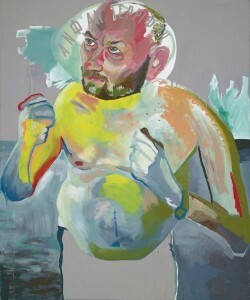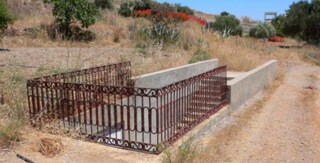At the Hamburger Bahnhof
Daniel Miller
Martin Kippenberger would have been celebrating his 60th birthday two months ago, if he hadn’t died of liver cancer at the age of 44, and it’s conceivable he’d still be celebrating now, drinking in a dive bar until dawn in Dawson City, or Vienna, or the Belgian quarter of Cologne, because to be himself, he needed other people, but he also needed to create a blur between himself and them, because otherwise everything was too intense.
But Kippenberger – artist, punk, provocateur and Zwangsbeglucktertum (‘someone who forces others to have fun’) – has ceased refilling people's glasses, and disco dancing in his underwear, leaving Berlin’s Hamburger Bahnhof at liberty to mark his birthday in a drier way, with a self-approving exhibition entitled Sehr Gut/Very Good, when ‘So Ein Blech/A Lot of Crap’ would have been more in tune with Kippenberger's democratically expansive spirit and, it must be said, much of his art.
Kippenberger enjoyed just one solo gallery show in Germany during his lifetime: Miete Strom Gas (‘Rent Electricity Gas’) at the Hessisches Landesmuseum in Darmstadt in 1986, featuring works produced during his ‘Magical Misery Tour’ through Brazil the previous winter. Travelling with the painter Albert Oehlen, Kippenberger kept a diary, played punk shows, created sketches, and bought a disused gas station in Salvador de Bahia, renamed it the Martin Bormann Gas Station, installed a phone line, and instructed his employees to answer calls: ‘Tankstelle Martin Bormann.’ Predictably, perhaps, the wall-sized photographic monochrome documenting the enterprise does not appear at Friedrich Flick's Hamburger Bahnhof.
Kippenberger's reputation has inflated since his death; when still ‘one of us, amongst us, with us’ (to take the title of an early painting), delivering long, boring monologues, paying his restaurant bills with shit-faced sculptures, and maliciously reducing girls to tears (Kippenberger once asked a fat woman with whom he was leaving a club: ‘Shall we walk down the hill, or just roll?’) his works were going for around $10,000 at auction. After posthumous appearances at Documenta X, the Venice Biennale, the MOCA in Los Angeles and Tate Modern, and the spectacular expansion of the contemporary art world over the last two decades, a mediocre 1992 self-portrait went at Christie’s in October 2012 for £3.2 million.
Very Good includes this painting, together with a reliquary of artefacts including family photographs, exhibition posters, a library of small-circulation books (displayed, contemptuously and absurdly, in locked cabinets, so that the public cannot read them), sculptures, photographs, and outsized wall-texts of the artist's favorite maxims; the Yogi Berra-esque ‘Never give up before it's too late!’ and the strangely reassuring ‘Embarrassment has no limits.’ Absent, along with Bormann, are Kippenberger's 1994 surrealist installation The Happy End of Franz Kafka’s ‘Amerika’, several dozen chairs and tables on an artificial football pitch; and concrete evidence of Metro-Net, Kippenberger's quixotic 1990s project for a planetary subway system, for which he built entrances and ventilation ducts in various locations around the world. If you go into one you are met with a chained gate, the sun-breast-hammer emblem of the Lord Jim's Lodge, Kippenberger's fictitious men's club, and its cryptic slogan: ‘Keiner hilft Keinem’ (‘Nobody Helps Nobody’).
Biographically selective and conceptually conservative, the idea behind this exhibition is straightforward: to canonise Kippenberger, and induct him into respectable art history; that is, to celebrate his death, and the opportunities which it presents within the eternal art world competition for society's diminishing attention span. Kippenberger, I think, would have detested it. ‘What remains is a domesticated Kippenberger – Kippenberger without the embarrassment,’ Susanne Kippenberger wrote recently about her brother’s posthumous reception. ‘But without embarrassment there's no Kippenberger left.’
The most vivid work on show is not by him. Gisela Stelly’s 1978 film Liebe und Abenteuer (‘Love and Adventure’), which Kippenberger helped get made, depicts the artist deadpan, as a watchman, in white make-up and a leather trenchcoat, joking on the platform of a U-bahn station, to the tune of Baccara's anthem to casual prostitution ‘Yes Sir, I Can Boogie’, as his colleagues throw around a ball of paper, and the 17-year-old Brigitt Hoffmeister looks on.



Comments